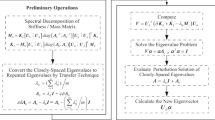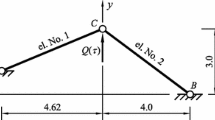Abstract
It has been extensively recognized that the engineering structures are becoming increasingly precise and complex, which makes the requirements of design and analysis more and more rigorous. Therefore the uncertainty effects are indispensable during the process of product development. Besides, iterative calculations, which are usually unaffordable in calculative efforts, are unavoidable if we want to achieve the best design. Taking uncertainty effects into consideration, matrix perturbation methodpermits quick sensitivity analysis and structural dynamic re-analysis, it can also overcome the difficulties in computational costs. Owing to the situations above, matrix perturbation method has been investigated by researchers worldwide recently. However, in the existing matrix perturbation methods, correlation coefficient matrix of random structural parameters, which is barely achievable in engineering practice, has to be given or to be assumed during the computational process. This has become the bottleneck of application for matrix perturbation method. In this paper, we aim to develop an executable approach, which contributes to the application of matrix perturbation method. In the present research, the first-order perturbation of structural vibration eigenvalues and eigenvectors is derived on the basis of the matrix perturbation theory when structural parameters such as stiffness and mass have changed. Combining the first-order perturbation of structural vibration eigenvalues and eigenvectors with the probability theory, the variance of structural random eigenvalue is derived from the perturbation of stiffness matrix, the perturbation of mass matrix and the eigenvector of baseline-structure directly. Hence the Direct-Variance-Analysis (DVA) method is developed to assess the variation range of the structural random eigenvalues without correlation coefficient matrix being involved. The feasibility of the DVA method is verified with two numerical examples (one is truss-system and the other is wing structure of MA700 commercial aircraft), in which the DVA method also shows superiority in computational efficiency when compared to the Monte-Carlo method.
Similar content being viewed by others
References
Topping B H V, Neves L F, Barros R C. Trends in Civil and Structural Engineering Computing. Stirlingshire: Saxe-Coburg Publications, 2009
Barth T. A Brief Overview of Uncertainty Quantification and Error Estimation in Numerical Simulation. NASA Ames Research Center, NASA Report, 2011
David E S, Michael B, Obaid Y. Systems Engineering and Program Management Trends and Costs for Aircraft and Guided Weapons Programs. Santa Monica: Rand Corporation Publication, 2006
Andrew S, Mike G. Trends in complex systems acquisition. Rusi Defense System, 2009, 2: 74–77
Zang T A. Needs and Opportunities for Uncertainty-Based Multidisciplinary Design Methods for Aerospace Vehicles. NASA Report, TM-2002-211462, 2002
Measurement uncertainty analysis principle and methods. In: NASA Measurement Quality Assurance Handbook. Washington D.C.: NASA, 2010
Roy C, Oberkampf W. A complete framework for verification, validation, and uncertainty quantification in scientific computing. AIAA J, 2010, 2: 4–7
Ni Z, Qiu Z P. Interval design point method for calculating the reliability of structural systems. Sci China Phys Mech Astron, 2013, 56: 2151–2161
Qiu Z P, Huang R, Wang X J, et al. Structural reliability analysis and reliability-based design optimization: Recent advances. Sci China Phys Mech Astron, 2013, 56: 1611–1618
Oberkampf W, Helton J C, Joslyn C A, et al. Challenge problems: uncertainty in system response given uncertain parameters. Reliabil Eng Syst Safety, 2004, 85: 11–19
Elishakoff I, Wang X J, Hu J X, et al. Minimization of the least favorable static response of a two-span beam subject to uncertain loading. Thin-Wall Struct, 2013, 79: 49–56
Wu F Q, Yao W X. A model of the fatigue life distribution of composite laminates based on their static strength distribution. Chin J Aeron, 2008, 21: 241–246
Gumbert C, Hou G, Newman P. Reliability assessment of a robust design under uncertainty for a 3-D flexible wing. AIAA-2003-4094
Chen S H. Matrix Perturbation Theory in Structure Vibration Analysis. Chongqing: Chongqing Publishing House, 1991
Qiu Z P, Chen S H, Elishakoff I. Natural frequencies of structures with uncertain but nonrandom parameters. J Optim Theory Appl, 1995, 86: 669–683
Yang X W, Chen S H, Wu B S. Eigenvalue reanalysis of structures using perturbation and PADE approximation. Mech Syst Signal Proc, 2001, 15: 257–263
Kleiber M, Hien T D. The Stochastic Finite Element Method: Basic Perturbation Technique and Computer Implementation. New York: Wiley, 1992
Graham L, Deodatis G. Response and eigenvalue analysis of stochastic finite element systems with multiple correlated material and geometric properties. Probab Eng Mech, 2001, 16: 11–29
Pradlwarter H J, Schuëller G I, Székely G S. Random eigenvalue problems for large systems. Comp Struct, 2002, 80: 2415–2424
Kaminski M, Solecka M. Optimization of the truss-type structures using the generalized perturbation-based stochastic finite element method. Finite Elements Analysis Design, 2013, 63: 69–79
Debraj G. Application of the random eigenvalue problem in forced response analysis of a linear stochastic structure. Archive Appl Mech, 2013, 4: 23–28
William S M. Anti-optimization of uncertain structures using interval analysis. Comput Struct, 2001, 79: 421–430
Qiu Z P, Elishakoff I. Anti-optimization of structures with large uncertain-but-non-random parameters via interval analysis. Comput Methodsin Appl Mechanicsand Eng, 1998, 152: 361–372
Author information
Authors and Affiliations
Corresponding author
Rights and permissions
About this article
Cite this article
Qiu, Z., Qiu, H. A direct-variance-analysis method for generalized stochastic eigenvalue problem based on matrix perturbation theory. Sci. China Technol. Sci. 57, 1238–1248 (2014). https://doi.org/10.1007/s11431-014-5563-8
Received:
Accepted:
Published:
Issue Date:
DOI: https://doi.org/10.1007/s11431-014-5563-8




